
News Archive
| 2024 | 2023 | 2022 | 2021 | 2020 | 2019 | 2018 | 2017 | 2016 | 2015 | 2014 | 2013 | 2012 | 2011 | 2010 |
| December | November | October | September | August | July | June | May | April | March | February | January |
2010-12-30: Audi's Le Mans winning R15 plus TDI in detail ...
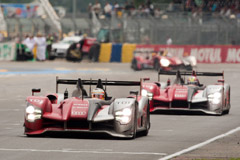 At Le Mans this June, Audi scored its ninth win in the legendary 24-hour race in just twelve attempts. It was probably the most unlikely of all their wins as the German team looked utterly on the back-foot for much of the race. Their more conservative tactic paid off in the end as the three much faster Peugeots still running on Sunday all retired with a spectacular engine blow-up. This resulted in a one-two-three victory for Audi and its innovative R15 plus TDI. Not only had the Germans swept the podium but also shattered the distance record that had stood since 1971. As its name suggests, the R15 plus was an evolution of the V10 engined R15 that had a troublesome debut season in 2009. Its ingenious but also complicated aerodynamics package had proven too much for even Audi's talented squad to handle. The changes made to create the 'plus' still looked insufficient to get on a level playing field with the very fast Peugeots, which dominated the year before and after Le Mans. Fortunately for Audi, all pieces fell into place when it mattered most. Next year massive rule changes will come into effect, forcing Audi and Peugeot to both build brand new cars. Audi has already revealed the new R18 TDI, which combines some of the R15 plus' aero cues with a fixed-head roof for better efficiency.
At Le Mans this June, Audi scored its ninth win in the legendary 24-hour race in just twelve attempts. It was probably the most unlikely of all their wins as the German team looked utterly on the back-foot for much of the race. Their more conservative tactic paid off in the end as the three much faster Peugeots still running on Sunday all retired with a spectacular engine blow-up. This resulted in a one-two-three victory for Audi and its innovative R15 plus TDI. Not only had the Germans swept the podium but also shattered the distance record that had stood since 1971. As its name suggests, the R15 plus was an evolution of the V10 engined R15 that had a troublesome debut season in 2009. Its ingenious but also complicated aerodynamics package had proven too much for even Audi's talented squad to handle. The changes made to create the 'plus' still looked insufficient to get on a level playing field with the very fast Peugeots, which dominated the year before and after Le Mans. Fortunately for Audi, all pieces fell into place when it mattered most. Next year massive rule changes will come into effect, forcing Audi and Peugeot to both build brand new cars. Audi has already revealed the new R18 TDI, which combines some of the R15 plus' aero cues with a fixed-head roof for better efficiency.In honour of Audi's Ferrari equalling ninth win in the 24 Hours of Le Mans, we have dedicated our final news feature of the year to the R15 plus TDI. Our detailed technical and season review is illustrated by a colourful 48-shot gallery complete with pictures of the car's engine. With the new rules designed to peg the cars back considerably, the R15 plus is set to remain the fastest to have ever won at Le Mans for a long time to come. |
2010-12-27: Sole surviving Alan Mann Lightweight Ford GT40 ...
 Last month we highlighted one of the rare variants of the successful Ford GT40 family; the GT Roadster, and for today we take a closer look at an even rarer specimen; the GT40 'AM Lightweight'. This car was the second of five bare tubs picked up by legendary privateer outfit Alan Mann directly from Abbey Panels late in 1965. Three were built up as 'regular' big-block Mk IIs by Mann's mechanics and completed by Carroll Shelby in the United States. The other two received the familiar 4.7 litre Ford small-block V8 but also many modifications to the chassis and body. Steel and fibreglass bits were replaced by aluminium to create two of the lightest GT40s ever built. In this guise they were only rarely raced as Ford urged Mann to campaign his big-block cars instead. Our feature car is the sole survivor and was raced with great success by Paul Hawkins, converted back to standard trim for homologation purposes, in 1967 and 1968, racking up more victories than any other GT40. The car has remained in this trim until this year when it was completely restored to its original guise by Lanzante Motorsport. Chassis AM GT-2 was completed just in time for the Goodwood Revival where it was spectacularly raced in the Whitsun Trophy for the owner by Ray Bellm.
Last month we highlighted one of the rare variants of the successful Ford GT40 family; the GT Roadster, and for today we take a closer look at an even rarer specimen; the GT40 'AM Lightweight'. This car was the second of five bare tubs picked up by legendary privateer outfit Alan Mann directly from Abbey Panels late in 1965. Three were built up as 'regular' big-block Mk IIs by Mann's mechanics and completed by Carroll Shelby in the United States. The other two received the familiar 4.7 litre Ford small-block V8 but also many modifications to the chassis and body. Steel and fibreglass bits were replaced by aluminium to create two of the lightest GT40s ever built. In this guise they were only rarely raced as Ford urged Mann to campaign his big-block cars instead. Our feature car is the sole survivor and was raced with great success by Paul Hawkins, converted back to standard trim for homologation purposes, in 1967 and 1968, racking up more victories than any other GT40. The car has remained in this trim until this year when it was completely restored to its original guise by Lanzante Motorsport. Chassis AM GT-2 was completed just in time for the Goodwood Revival where it was spectacularly raced in the Whitsun Trophy for the owner by Ray Bellm. |
|
2010-12-23: Bugatti Type 57 SC Atlantic; our car of the year ...
 This was certainly the year of the Bugatti Type 57 SC Atlantic Coupe; in April one was sold for a record smashing price and in August a resurrected example debuted at the Pebble Beach Concours d'Elegance. Just four examples of this spectacular Bugatti were built between 1936 and 1938, and only two have survived as complete cars. The distinguishing feature of the Altantic are the rivet 'spines' running from front to back over the various panels. These can be traced back to the 'Aerolithe' show car built in 1935, which reportedly was constructed from the very volatile magnesium alloy 'Electron'. For obvious reasons the panels could not be melded, so they had to be riveted together much like on contemporary airplanes. The 'production' Atlantic bodies were built from aluminium but the spines were carried over to give the car its distinct styling.
This was certainly the year of the Bugatti Type 57 SC Atlantic Coupe; in April one was sold for a record smashing price and in August a resurrected example debuted at the Pebble Beach Concours d'Elegance. Just four examples of this spectacular Bugatti were built between 1936 and 1938, and only two have survived as complete cars. The distinguishing feature of the Altantic are the rivet 'spines' running from front to back over the various panels. These can be traced back to the 'Aerolithe' show car built in 1935, which reportedly was constructed from the very volatile magnesium alloy 'Electron'. For obvious reasons the panels could not be melded, so they had to be riveted together much like on contemporary airplanes. The 'production' Atlantic bodies were built from aluminium but the spines were carried over to give the car its distinct styling.As mentioned two have survived in complete order and had been in the same hands for decades. Sadly, the untimely death of the first car's owner in 2008 brought it to the market. In April a deal was struck by David Gooding between the widow and someone close to the newly opened Mullin Automotive Museum. The press-release merely stated that an amount in excess of $30 million was part of the transaction but rumours suggest it was actually around the $35 million mark. One car disappeared before the War and the final car was virtually demolished in a fatal collision with a train in 1955. This Atlantic had already been reconstructed in the 1970s but used very few original parts. Over the past two years this has been rectified for the current owner by master-restorer Paul Russell. The resulting Atlantic was shown at Pebble and sparked quite a bit of conversation. All this and much more can be found in detail in our report with individual chassis histories on all four Atlantics built. The article is illustrated by a spectacular 36-shot gallery. |
2010-12-20: Beautiful Alfa Romeo Giulia 1600 Sport in greater detail, McLaren racer and new MINI ...
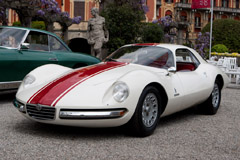 In 2010 two great Italian companies celebrated anniversaries; Alfa Romeo its 100th and Pininfarina its 80th. Today we honour both by taking a second look at the Pininfarina bodied Alfa Romeo Giulia 1600 Sport. The one-off show car made a very rare appearance at the Concorso d'Eleganza Villa d'Este this April. It was presented by its Japanese owner in a near time-warp condition, 45 years after it was first shown at the Turin Motor Show. For its originality, the car was awarded the FIVA award. Also on hand was the unique machine's designer Aldo Brovarone. The Alfa Romeo prototype was created during the peak of his career. The base for the Giulia 1600 Sport was the TZ2 competition car and Brovarone further accentuated the low height of the chassis by draping the body over it very tightly. Since its Turin debut the small coupe has only very rarely been seen and little has been written about it.
In 2010 two great Italian companies celebrated anniversaries; Alfa Romeo its 100th and Pininfarina its 80th. Today we honour both by taking a second look at the Pininfarina bodied Alfa Romeo Giulia 1600 Sport. The one-off show car made a very rare appearance at the Concorso d'Eleganza Villa d'Este this April. It was presented by its Japanese owner in a near time-warp condition, 45 years after it was first shown at the Turin Motor Show. For its originality, the car was awarded the FIVA award. Also on hand was the unique machine's designer Aldo Brovarone. The Alfa Romeo prototype was created during the peak of his career. The base for the Giulia 1600 Sport was the TZ2 competition car and Brovarone further accentuated the low height of the chassis by draping the body over it very tightly. Since its Turin debut the small coupe has only very rarely been seen and little has been written about it.We jumped at the opportunity presented at Villa d'Este and captured every intricate detail of the beautiful Alfa Romeo. Using the eighteen best shots, we have compiled this exclusive gallery. Late last week, McLaren confirmed the very strong rumours that a GT3 version of the upcoming MP4-12C sports car was readied. As part of its development program, it will compete in select races in 2011 before being offered to customers from 2012 onwards. MINI released the first details of the Paceman Concept, which is due to be unveiled at the NAIAS in January. Powered by the familiar turbocharged four-cylinder engine, it is an unusual mix of a SUV and the regular MINI hatchback. |
|
2010-12-16: Jim Clarks' 1965 Indy 500 winning Lotus 38 Ford and the latest news ...
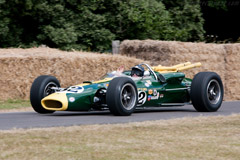 In December, we traditionally take a look at the finest cars that we saw and/or were launched during the year. This year is no exception as today we have highlighted the legendary Lotus 38 Ford. This is the very car used by Jim Clark to win the Indy 500 in 1965. It proved to be a historic victory as it was the first for a mid-engined car, the first for a Ford engine, the first for a British car and Clark was the first foreign winner since 1915. Clark was also the first driver to complete the 500-mile race with an average of over 150 mph (241 km/h). Ford retained the winning car after the race and for many years it was proudly displayed in the lovely 'Henry Ford' museum. Last year the decision was made to have the car restored to full running order and the Lotus 38 was handed to Classic Team Lotus, where some of the machine's original builders lent a hand. They carefully preserved the car's unique original condition, replacing only consumables like rubber seals and hoses. Clark's winning Lotus made its post restoration debut at Goodwood Festival of Speed, where it ran under its own power for the first time since 1965. It was driven by event host Lord March and Sir Jackie Stewart who, as a touching tribute to his late friend and rival, wore a replica of Clark's helmet. Later in the year chassis 38/1 was also show at Pebble Beach and demonstrated by 2010 Indy winner and fellow Scot, Dario Franchitti, at the 'Brickyard'.
In December, we traditionally take a look at the finest cars that we saw and/or were launched during the year. This year is no exception as today we have highlighted the legendary Lotus 38 Ford. This is the very car used by Jim Clark to win the Indy 500 in 1965. It proved to be a historic victory as it was the first for a mid-engined car, the first for a Ford engine, the first for a British car and Clark was the first foreign winner since 1915. Clark was also the first driver to complete the 500-mile race with an average of over 150 mph (241 km/h). Ford retained the winning car after the race and for many years it was proudly displayed in the lovely 'Henry Ford' museum. Last year the decision was made to have the car restored to full running order and the Lotus 38 was handed to Classic Team Lotus, where some of the machine's original builders lent a hand. They carefully preserved the car's unique original condition, replacing only consumables like rubber seals and hoses. Clark's winning Lotus made its post restoration debut at Goodwood Festival of Speed, where it ran under its own power for the first time since 1965. It was driven by event host Lord March and Sir Jackie Stewart who, as a touching tribute to his late friend and rival, wore a replica of Clark's helmet. Later in the year chassis 38/1 was also show at Pebble Beach and demonstrated by 2010 Indy winner and fellow Scot, Dario Franchitti, at the 'Brickyard'.We captured the Lotus 38 in great detail at Goodwood and were fortunate enough to snap some details with the panels removed. This has resulted in a 18-shot gallery to illustrate our in-depth article. Despite the time of the year, some new cars were also announced this week. Vauxhall revealed the latest VXR8. The Holden/HSV based sedan features a 431 bhp engine. Ahead of the official launch at Detroit, Honda released a sketch of the Civic Concept, which in itself is a preview of the upcoming new Civic. Cadillac announced its return to racing in 2011 when it will field the CTS-V Coupe Race Car in the SCCA World Challenge. |
2010-12-13: Tom Walkinshaw tribute and new GT-racers from Porsche and Ferrari ...
 Sad news reached us is this morning of the passing of racing icon Tom Walkinshaw at the young age of just 64. He had been involved in motorsport in many capacities for the better part of four decades. His most recent exploits included ownership of Holden's tuning HSV but he is best known for successfully running Jaguar's works touring and sports car team. To honour his legacy we have highlighted the first Jaguar prepared by TWR and raced by Walkinshaw himself. This is XJ-S TWR Group A that was originally built for the European Touring Car Championship. Powered by a production-based V12 engine, it successfully challenged the dominant BMWs, winning several races in its first season. More victories were scored in 1983 but the championship still eluded the team. With some Cosworth-sourced tweaks the V12 produced 450 bhp in 1984 and nothing could stop the spectacular Jaguars. The team won seven ETCC races, including the Spa 24 Hours, which was the first 24-hour victory for Jaguar since Le Mans, 1957. Walkinshaw himself was crowned European Champion. A year later a privately entered XJ-S also took a victory in Australia's Bathurst 1000. By that time development of the even more successful Group C cars was already well under way. With Walkinshaw at the helm, Jaguar would add two more Le Mans wins to their tally with the TWR developed XJR-9 and XJR-12 respectively.
Sad news reached us is this morning of the passing of racing icon Tom Walkinshaw at the young age of just 64. He had been involved in motorsport in many capacities for the better part of four decades. His most recent exploits included ownership of Holden's tuning HSV but he is best known for successfully running Jaguar's works touring and sports car team. To honour his legacy we have highlighted the first Jaguar prepared by TWR and raced by Walkinshaw himself. This is XJ-S TWR Group A that was originally built for the European Touring Car Championship. Powered by a production-based V12 engine, it successfully challenged the dominant BMWs, winning several races in its first season. More victories were scored in 1983 but the championship still eluded the team. With some Cosworth-sourced tweaks the V12 produced 450 bhp in 1984 and nothing could stop the spectacular Jaguars. The team won seven ETCC races, including the Spa 24 Hours, which was the first 24-hour victory for Jaguar since Le Mans, 1957. Walkinshaw himself was crowned European Champion. A year later a privately entered XJ-S also took a victory in Australia's Bathurst 1000. By that time development of the even more successful Group C cars was already well under way. With Walkinshaw at the helm, Jaguar would add two more Le Mans wins to their tally with the TWR developed XJR-9 and XJR-12 respectively.Shortly after three more pictures of the 458 GTC surfaced, Porsche revealed the latest version of the 997 GT3 RSR. The 2011 evolution features many revisions, including a more powerful engine and also a modified aero package that generates more downforce. The latest machines from the two arch-rivals will face off for the first time during the Sebring 12 Hours in March. |
|
2010-12-11: Spectacular new Audi R18 TDI ...
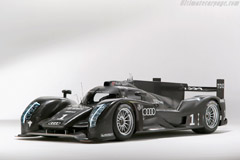 Yesterday Audi took the wraps off their highly anticipated new Le Mans challenger, the R18 TDI. Built to comply with the revised regulations, it is a drastic departure from the German manufacturer's highly successful petrol and diesel engined sports cars. The biggest news is that the R18 is a coupe just like the cars from rival Peugeot. A closer look reveals that the aerodynamics package is actually a development of the ultra-low approach of R15 plus that won Le Mans last year. There are bigger changes under the engine cover where a 3.7 litre V6 diesel is found. It may be coupled to a hybrid drive system, which will be fully legal from 2011 onwards for the first time, but Audi have not officially confirmed this. Another novelty is the six-speed gearbox, which replaces the five-speed used on Audi's previous diesel cars.
Yesterday Audi took the wraps off their highly anticipated new Le Mans challenger, the R18 TDI. Built to comply with the revised regulations, it is a drastic departure from the German manufacturer's highly successful petrol and diesel engined sports cars. The biggest news is that the R18 is a coupe just like the cars from rival Peugeot. A closer look reveals that the aerodynamics package is actually a development of the ultra-low approach of R15 plus that won Le Mans last year. There are bigger changes under the engine cover where a 3.7 litre V6 diesel is found. It may be coupled to a hybrid drive system, which will be fully legal from 2011 onwards for the first time, but Audi have not officially confirmed this. Another novelty is the six-speed gearbox, which replaces the five-speed used on Audi's previous diesel cars.Along with the spectacular R18 TDI, Audi also announced their competition plans for 2011. They will race at Sebring with a modified R15 plus and debut the R18 at the Spa Six Hours race, which has become the traditional final dress rehearsal for Le Mans. It will certainly be a very exciting season as for the first time Audi and Peugeot will be fielding brand new cars. |
2010-12-10: New BMW 1 Series M Coupe and Renault Megane RS tarmac racer ...
 At next month's North American International Auto Show (NAIAS) in Detroit, BMW will finally release the official M version of their smallest model. Dubbed the 1 Series M Coupe, it is in many ways the spiritual successor to the original M3 of the 1980s. The compact machine boasts the now familiar twin-turbo straight six engine, which is wound up to 340 bhp for this application. Purists will be happy to hear that all that power is transferred to the rear wheels through a manual six-speed gearbox. Weighing in at just under 1500 kg (3300 lbs), the new M Coupe can accelerate to 100 km/h (62 mph) in less than 5 seconds. Top speed is officially limited to 250 km/h (155 mph). There is nothing subtle to the exterior treatment; the car really looks like a 1 Series on steroids with wildly flared wheel arches to clear the massive wheels. Inside the car is fully equipped and the car is ready to communicate with the latest smart-phones. After its Detroit world debut, the 1 Series M Coupe will be available on the market in Germany from May 2011.
At next month's North American International Auto Show (NAIAS) in Detroit, BMW will finally release the official M version of their smallest model. Dubbed the 1 Series M Coupe, it is in many ways the spiritual successor to the original M3 of the 1980s. The compact machine boasts the now familiar twin-turbo straight six engine, which is wound up to 340 bhp for this application. Purists will be happy to hear that all that power is transferred to the rear wheels through a manual six-speed gearbox. Weighing in at just under 1500 kg (3300 lbs), the new M Coupe can accelerate to 100 km/h (62 mph) in less than 5 seconds. Top speed is officially limited to 250 km/h (155 mph). There is nothing subtle to the exterior treatment; the car really looks like a 1 Series on steroids with wildly flared wheel arches to clear the massive wheels. Inside the car is fully equipped and the car is ready to communicate with the latest smart-phones. After its Detroit world debut, the 1 Series M Coupe will be available on the market in Germany from May 2011.Renault Sport have further expanded their rally car range with the Megane RS N4. Built specifically for tarmac events, the racer has remained true to the Megane road car it is based on. The majority of changes made have focused on safety provisions like a roll cage. The turbocharged four cylinder engine is good for 265 horses, which is 15 more than in the road car. Torque is up considerably more though from 340 Nm (251 ft lbs) to a hefty 470 Nm (347 ft lbs). The suspension features three-way adjustable dampers. The Megane RS N4 kit is available from 57,000 Euro. |
|
2010-12-08: Two early Duesenberg road cars and the first glimpse of the Ferrari 458 GT2 ...
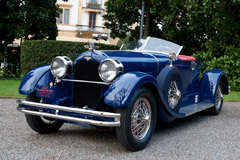 Legendary American manufacturer Duesenberg is today best known for the fantastic Model J built in the late 1920s and throughout the 1930s, leaving the company's earlier road cars often overlooked. One of the main reasons is that only a handful of these sophisticated machines are left with many scrapped for the lightweight materials. Today we highlight two of these early Duesenbergs, which featured straight engines directly derived from the French Grand Prix and Indy winning competition Duesenbergs.
Legendary American manufacturer Duesenberg is today best known for the fantastic Model J built in the late 1920s and throughout the 1930s, leaving the company's earlier road cars often overlooked. One of the main reasons is that only a handful of these sophisticated machines are left with many scrapped for the lightweight materials. Today we highlight two of these early Duesenbergs, which featured straight engines directly derived from the French Grand Prix and Indy winning competition Duesenbergs.The earliest is this Model A, fitted with a 'standard' Sport Phaeton body constructed for Duesenberg by the Millspaugh & Irish company. Freshly restored it was displayed this summer at the Pebble Beach Concours d'Elegance and also participated in the Tour d'Elegance a few days earlier. One of the final cars produced using Duesenberg designed and built engines is Model X. It is most famous for its McFarlan 'Boat Roadster' body, which inspired the fabulous Speedsters built by, then sister company, Auburn. After changing hands numerous times before 1950, the influential car spent nearly half a century in storage. The current owner acquired it in the late 1990s and had it completely restored to its original configuration. The staggering result has since been awarded with numerous prizes at all the prestigious shows around the world. We captured the car this spring at the Concorso d'Eleganza Villa d'Este, where it duly won its class. Our article is illustrated by an exclusive 18-shot gallery of this unique Duesenberg. This morning one of our readers posted the first shot of what we believe is the upcoming Ferrari 458 GT2 on our forums. No technical details are available yet of the replacement of the all-conquering 430 GTC but the new racer certainly looks menacing. We will keep you updated when more information on the 458 GT2 is released. |
2010-12-06: Two Pebble winning Ferrari 212 Export Vignale Coupes ...
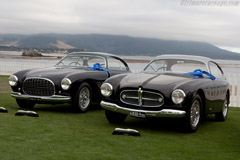 At this summer's Pebble Beach Concours d'Elegance two Ferrari 212 Export Vignale Coupes were entered in different classes: "Ferrari Grand Touring" and "Ferrari Competition". Benefitting from a fresh restoration to their original configuration, they both won the coveted 'Best in Class' award.
At this summer's Pebble Beach Concours d'Elegance two Ferrari 212 Export Vignale Coupes were entered in different classes: "Ferrari Grand Touring" and "Ferrari Competition". Benefitting from a fresh restoration to their original configuration, they both won the coveted 'Best in Class' award.The first example (chassis 0080E) was the second of seven 212 Exports fitted with a fixed head body by Vignale, following a Giovanni Michelotti design. It was first shown at the 1951 Turin Motor Show and spent most of its life in the United States. From a very early date, it lost its original colours in favour of a more fashionable red. It was only returned to its very elegant black and silver finish ahead of this year's concours season. In addition to winning its class at Pebble, it was also featured on the cover of the August/September issue of Cavallino Magazine. The second 212 (chassis 0092E) was raced in period on both sides of the Atlantic. It also served as Alberto Ascari's road car when he competed in the 1952 Indy 500 for Ferrari. At the end of the 1950s, it disappeared from the radar and did not make an appearance until August of this year. The current owner had the car completely restored to its original black and green configuration by Wayne Obry's Motion Products, who also applied the finishing touches to 0080E. Both spectacular Ferrari 212 Exports are pictured on the road during the Tour d'Elegance and on the Concours d'Elegance lawn as can be seen in our 18-shot gallery. |
|
2010-12-02: Prost's championship winning McLaren TAG-Porsche and news from Audi and Rinspeed ...
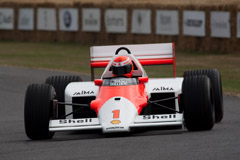 Under the guidance of new owner Ron Dennis, McLaren quickly returned from a grid-filler to its former glory in the early 1980s. The first step was the introduction of the ground-breaking carbon-fibre monocoque chassis designed by John Barnard, followed by the hiring of the experienced Niki Lauda and the talented Alain Prost. The final piece of the puzzle was the bespoke twin-turbo engine that was designed, engineered and built by Porsche, and funded by TAG. The result was the all-conquering McLaren MP4/2, which dominated the 1984 season and saw Lauda win his third driver's title. The car was so good that with only minor modifications it was used for two more seasons, both ending with Prost as the World Champion. At this year's Goodwood Festival of Speed, we were treated to one of McLaren's own MP4/2Cs, driven up the hill by the likes of Lewis Hamilton and Jenson Button. The latter explained that it had been the best day of his life. In addition to seeing the car in action we were also invited to take a closer look at the car, which in its day was guarded with great vigour. This has resulted in a spectacular 24-shot gallery with every detail of this highly impressive machine. Also featured is the example on display in Porsche's fabulous museum.
Under the guidance of new owner Ron Dennis, McLaren quickly returned from a grid-filler to its former glory in the early 1980s. The first step was the introduction of the ground-breaking carbon-fibre monocoque chassis designed by John Barnard, followed by the hiring of the experienced Niki Lauda and the talented Alain Prost. The final piece of the puzzle was the bespoke twin-turbo engine that was designed, engineered and built by Porsche, and funded by TAG. The result was the all-conquering McLaren MP4/2, which dominated the 1984 season and saw Lauda win his third driver's title. The car was so good that with only minor modifications it was used for two more seasons, both ending with Prost as the World Champion. At this year's Goodwood Festival of Speed, we were treated to one of McLaren's own MP4/2Cs, driven up the hill by the likes of Lewis Hamilton and Jenson Button. The latter explained that it had been the best day of his life. In addition to seeing the car in action we were also invited to take a closer look at the car, which in its day was guarded with great vigour. This has resulted in a spectacular 24-shot gallery with every detail of this highly impressive machine. Also featured is the example on display in Porsche's fabulous museum.German manufacturer Audi kicked December off with the introduction of all new generation A6. In the construction of the executive saloon a considerable amount of aluminium is used, saving quite a bit compared to an all-steel construction. At the early 2011 market launch, the new A6 is available with a choice of three petrol and two diesel engines. Later in the year a hybrid version is expected to join the line-up. Looking ahead to the upcoming Geneva Motor Show, Frank Rinderknecht released the first computer drawings of his latest creation. It is fittingly dubbed the Rinspeed BamBoo as many of the show car's interior components will be constructed from bamboo. |
| All Cars - Contact us - Privacy Statement - Top | © 1998 - 2024 Ultimatecarpage.com |

